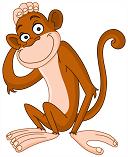Many of these can be asked either way round. For example: "What type of food forms the staple diet of a nucivorous animal?"
| An alate creature is one that has |
 |
Wings |
| An excaudate or anourous animal is one that has no |
 |
Tail |
| An apodous animal is one that has no |
 |
Feet |
| A catadromous animal is one that has |
 |
Migrates down rivers to the sea to breed |
| A diurnal animal is one that |
 |
Active during the daytime |
| An edentate animal is one that has no |
 |
Teeth |
| A glabrous animal is one that has no |
 |
Hair or fur |
| Common term for a homeothermic animal (cf. polikothermic) |
 |
Warm blooded |
| An oviparous animal is one that |
 |
Lay eggs |
| A palmiped is an animal that has |
 |
Webbed feet |
| Passerine birds are so called because their feet are specially adapted for |
 |
Perching |
| A pinniped is a |
 |
Mammal with flippers |
| A plantigrade animal is one that |
 |
Walks on flats of feet |
| Common term for a polikothermic animal (cf. homeothermic) |
 |
Cold–blooded |
| An ungulate is an animal that has |
 |
Hooves |
| A viviparous animal is one that is |
 |
Live young |
| Sleeping through the summer (the opposite of hibernation) |
 |
Aestivation |
| Person or animal with congenital lack of pigment |
 |
Albino |
| Biliverdin and bilirubin are (respectively) the yellow–orange and green pigments in
|
 |
Bile |
| Nidification (particularly of birds) |
 |
Building nests |
| Shell of a tortoise, crab or lobster (upper part – see also Plastron) |
 |
Carapace |
| Species able to breed with each other (from the Greek for common) |
 |
Cenospecies |
| Forms the hard parts of joint–footed animals, and insect skeletons |
 |
Chitin (kye–tin) |
| The Latin word for a sewer: the single orifice that serves as the only opening for the digestive, reproductive,
and urinary tracts in amphibians, reptiles, birds, and a few mammals |
 |
Cloaca |
| Common name for albumen |
 |
Egg white |
| Any gland that secretes hormones into the bloodstream |
 |
Endocrine gland |
| The nictitating membrane, or haw (present in some reptiles, birds, sharks, and mammals) is also known as the third |
 |
Eyelid |
| The joint in the hind leg of a quadruped, between the knee and the fetlock – the angle of which points
backwards |
 |
Hock (or gambrel) |
| Animal that has no backbone |
 |
Invertebrate |
| Tough, fibrous protein: the main constituent of rhino horns (and human hair) |
 |
Keratin |
| Sugar found in milk |
 |
Lactose |
| Mammal where the female carries the young in a pouch |
 |
Marsupial |
| The largest cells in the bodies of most animal species |
 |
Ova |
| Scents secreted by animals which act like hormones on others |
 |
Pheromones |
| Lower part of the shell of a tortoise or turtle – also a chest protector in fencing (the sport!) |
 |
Plastron |
| Slowing down of metabolic rates in cold–blooded animals for part of the day or night, to save energy |
 |
Torpor |
| Furcula (from the Latin for "little fork") – a bone in birds' skeletons |
 |
Wishbone |
| Disease caught by man from animals (e.g. ringworm, rabies) |
 |
Zoonosis |
| Animal that looks like a plant (e.g. sea anemone) |
 |
Zoophyte |

